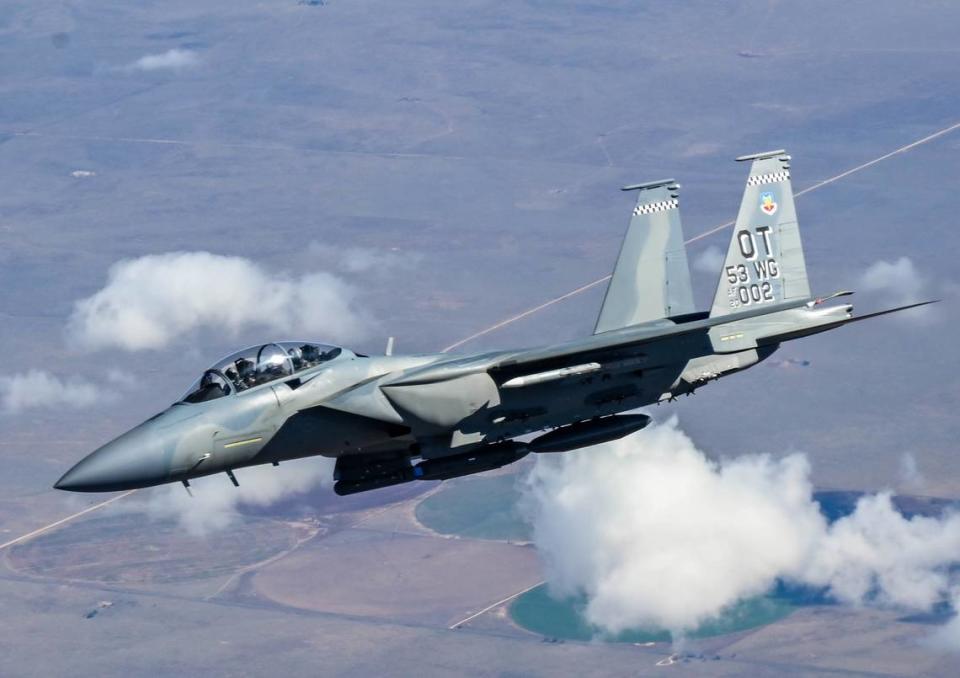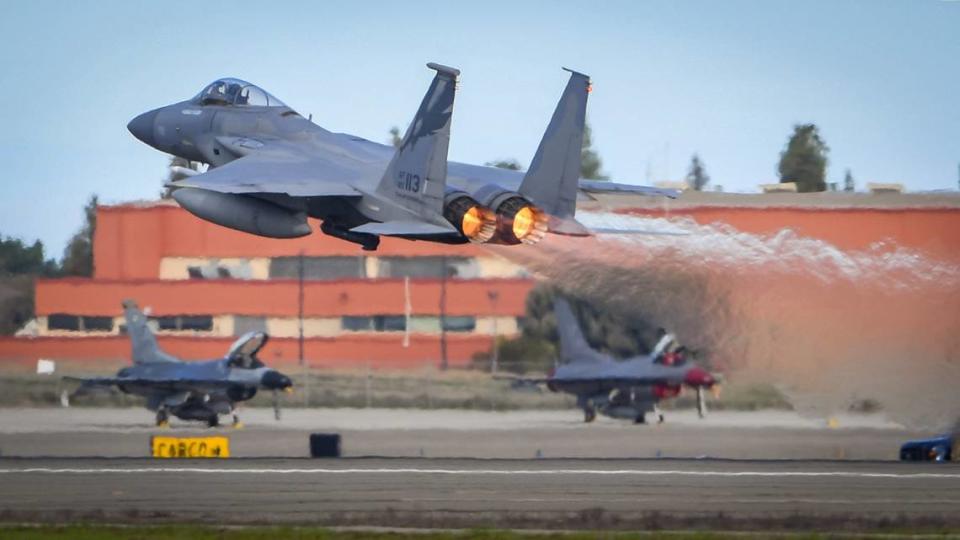Fresno chosen as one of three ‘preferred’ bases in U.S. for new Air Force fighter jets
The Fresno Air National Guard Base at Fresno Yosemite International Airport has been selected as one of three sites across the U.S. deemed as “preferred locations” to receive some of the U.S. Air Force’s newest fighter jets.
The selection of the Fresno base and a naval joint reserve base in Louisiana to be the “beddown” sites for the F-15EX Strike Eagle jets was reported Tuesday night by the Air Force in a statement on its news website.
After environmental assessments and a formalized decision in 2024 by the Secretary of the Air Force, deployment of the F-15EX fighters to the selected bases is expected in 2027 or 2028.
Another Air National Guard base in Westfield, Massachusetts, was tabbed by the Air Force to host a squadron of new F-35A Lightning II fighter jets.
The three bases were among four sites, including Lemoore Naval Air Station in Kings County, that had been in the running since last fall as the Air Force made plans for replacing outdated Air National Guard F-15 fighter jets. The competition among four bases for three squadrons set up a high-stakes game of musical chairs in which one community is destined to be disappointed when the decisions are finalized.
Had Lemoore been chosen as the site for the F-35A jets for the Air National Guard, representatives of the U.S. Department of Defense said that the Fresno-based 144th Fighter Wing would be relocated to the Navy air base at Lemoore.

Public affairs officials at the Fresno base were still awaiting official confirmation Wednesday afternoon from the Air Force about the selection.
In a statement issued Wednesday afternoon, Fresno Mayor Jerry Dyer said he was pleased with the news. “I’m extremely passionate about the 144th Fighter Wing and the pride it brings to Fresno,” Dyer said. “We’ve been happy to advocate for the 144th and we are beyond excited to have this incredible asset added to our base, while also keeping jobs and people here.”
“It’s an honor to have this squadron based in Fresno and defending the entire western United States,” he added.
Dyer and Rep. Jim Costa, D-Fresno, in an opinion article published in The Fresno Bee last fall, described the Fresno Air National Guard Base and the 144th Fighter Wing as “one of Fresno’s most valued employers” with more than 1,100 military and civilian personnel.
The F-15EX Strike Eagle will replace the F-15 C and D models that have been based in Fresno since 2013. Those aircraft are approaching the end of their service lives.

The Air Force reported that the beddown decision came after site surveys were conducted at each of the locations being considered to assess the site’s ability to meet the mission and infrastructure needs, community support, environmental factors and cost.
The Air National Guard’s future F-15EX squadron at the Fresno and Louisiana bases are expected to include 18 aircraft and add about 100 new personnel to each base.
The Air Force’s statement Tuesday did not elaborate on what changes would need to take place at the 144th Fighter Wing to prepare for the replacement aircraft and additional workers. The military had previously indicated that it was studying several options for how the Fresno Air National Guard base could be configured, depending on the construction projects required to accommodate the new jets.
One option calls for nearly all of the new construction — a new main gate to the base, fire station, medical training facility, munitions office — and renovation of existing structures including squadron operations, an alert crew facility and maintenance buildings, to occur within the existing footprint of the base along McKinley Avenue, south of the Fresno Yosemite International Airport runways.
A second option would move the entire “cantonment area” of the installation to north of the runways, where it would largely displace the existing Airways Golf Course along Airways Avenue west of Clovis Avenue.
About the aircraft
The F-15EX Strike Eagle, also called the Eagle II, is manufactured by Boeing. It is described as a multi-role fighter that measures almost 64 feet long with a wingspan of about 43 feet. It can fly at speeds of about 1,900 mph or Mach 2.5, or 2 1/2 times the speed of sound. It has a combat range of 1,100 miles and can reach altitudes of up to 60,000 feet.
With its longer range and greater payload than its predecessor Eagle, the Strike Eagle can carry almost 30,000 pounds of ordnance on external weapons points.
The Air Force’s original purchase of F-15EX jets was sliced from 144 to 80 aircraft as part of the 2023 budget, according to a report last fall by the website BreakingDefense.com. The website reported that the buy would replace older aircraft for only about three existing Air Force or Air National Guard squadrons, leaving five other squadrons of F-15 C and D models without replacements by either F-15EX or F-35A fighter jets.
Air National Guard history in Fresno
The 144th Fighter Wing traces its roots to 1948, within months of the establishment of the Air National Guard. Originally based in Alameda, the 61st Fighter Wing and, later the 194th Fighter Squadron, flew a combination of T-6 training aircraft, a B-26 bomber, a C-47 cargo transport, an L-17 liaison aircraft, and a pair of P-51 Mustang fighters. The P-51s were flown until late 1954.
According to a unit history on the wing’s website, the 61st Fighter Wing was redesignated in 1950 as the 144th Fighter Bomber Wing.
By 1954, the unit had transitioned from its propeller-driven P-51s to the jet-powered F-86A Sabre, and the 194th Fighter Squadron relocated to Fresno.
The 144th unit was reclassified as the 144th Fighter Interceptor Wing in 1955, and the wing followed the 194th squadron to Fresno in 1957.
In 1958, the wing’s aircraft were replaced with newer F-86L Sabres, which served untl 1964 when the F-102 Delta Dagger was put into service. The F-106 Delta Dart followed in 1974.
In 1984, the 144th received the F-4D Phantom jets, which were followed in 1989 by the F-16A Fighting Falcon. A newer version of the Falcon, the F-16C, arrived in 1995.
The wing flew the Fighting Falcons until 2013, when a transition to the first F-15 Eagle fighter jets arrived.
In addition to the actual squadron of fighter aircraft and flight operations, the wing’s presence at Fresno Yosemite International Airport includes a headquarters staff and units for maintenance, civil engineering, security, logistics, communications and medical needs.

